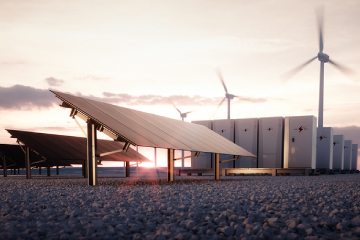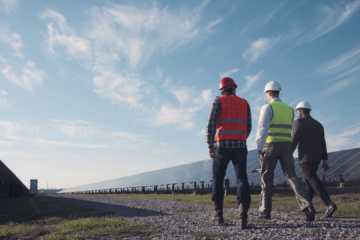- About UsAbout UsWe’re committed to providing future generations with the means to power their lives in the most economic, environmental and socially responsible ways possible.
- What We DoWhat We DoWe are a market-leading, independent power producer and service provider, delivering: wind (onshore and offshore), solar photovoltaic, storage, and electrical vehicle charging.
- Landowners
- Suppliers
- Projects
- Careers
- News
- Contact
A Balanced Perspective on the Inflation Reduction Act

By Virinder Singh, Vice President, Regulatory & Legislative Affairs
Passed in August 2022, the Inflation Reduction Act (IRA) is landmark legislation that will shape our nation’s economy – as well as the economies of other countries – for decades to come. As we approach the IRA’s first anniversary, its positive impacts can already be seen in project and investment announcements and jobs created. However, it’s also important to recognize the ways in which the IRA’s incentives have the potential to negatively affect some renewable energy markets.
To be certain, the IRA will play a central role in decarbonizing the US energy sector. By extending existing tax credits for wind and solar for 10 additional years, it provides the certainty needed to encourage long-term investments that will continue to make renewables even more affordable than they are today.
It also creates many new incentives, including tax credits for energy storage that will be key in supporting the clean energy transition and ensuring the reliability of the electrical grid. Whereas previous incentives for energy storage promoted co-locating it with solar, the new incentives will allow more efficient siting for standalone energy storage that optimizes its location based on the needs of the grid.
Another major element of the IRA is the advanced manufacturing tax credit, which will play a significant role in creating a domestic clean energy industry supply chain – and many of these new manufacturing facilities and associated jobs will be located in conservative areas of the country. As someone who spent part of his childhood 15 miles from President Biden’s now-famous working-class town of Scranton, Pennsylvania, I have seen communities suffer the loss of manufacturing jobs, and it’s wonderful to see investment returning to these places.
These are just a few examples of the myriad benefits resulting from the IRA. But the legislation has some shortcomings – chief among which is that it doesn’t include incentives to build transmission. We simply don’t have enough wire to get electrons from wind and solar facilities to load, and this is perhaps the greatest impediment we face in achieving a net-zero electricity supply.
A related, but less-obvious threat resulting from the IRA is that it effectively delivers a double whammy to solar developers who now have the ability to choose between the production tax credit (PTC) and the investment tax credit (ITC).
While the PTC may appear to offer better returns than the ITC, the PTC can induce negative pricing, such that in areas oversupplied with PTC-based solar projects, wholesale power prices may fall below $0 per megawatt hour. As a result, projects that are not receiving the PTC (either because they are ITC based, or because they have been in operation for more than 10 years and are no longer eligible for PTCs), generating power means operating at a loss. And in a transmission-constrained market, the likelihood of generation curtailment increases, which for PTC-funded projects means losing PTCs in addition to energy-related revenues for every megawatt-hour curtailed.
Renewable energy project owners with experience in the wind industry are all too familiar with the double punch negative pricing and how curtailment can reflect on project financials, but newer entrants and those whose experience is limited to the solar sector may not understand the risks that lie ahead.
EDF Renewables has been strongly encouraging our industry peers to temper the understandable enthusiasm inspired by the IRA with pragmatic understanding of the market inefficiencies created by one-sided incentives focused on generation and the challenges posed by a lack of transmission.
It’s essential that developers incorporate negative pricing and curtailment in their financial models early in the process to understand how these factors will affect project economics, and design and value their projects accordingly. Failure to do so will result in unrealistically low bids that distort the market and ultimately harm all participants – particularly investors.
As work to facilitate the development of transmission continues, it’s heartening to note that awareness of the issue and its connection to climate change has increased significantly among environmental NGOs, the mainstream media, and the general public. It’s also important to acknowledge that progress is being made by several regional transmission organizations, with NYISO, MISO and CAISO recently approving billions of dollars’ worth of system upgrades. While these activities may not stimulate the level of fanfare and excitement associated with inter-regional transmission projects, they are equally valuable and will produce meaningful benefits over time.
Reflecting on the past eleven months, it’s clear that the IRA is delivering on its promise and will have a transformative effect on many parts of our country. However, the bulk of the work lies ahead of us. This includes not only the nitty-gritty managerial work of implementation, but also engagement and advocacy work to ensure support for the IRA remains strong.
Passed on a partisan basis, some Republican lawmakers have sought to weaken the IRA’s incentives, despite the fact that Republican districts are the biggest winners from renewable energy and manufacturing investment. This is true at the time wind and solar projects are constructed, as well as over the 20-30-year course of their operational lives as they continue to generate substantial revenue for their host communities through land-lease payments and tax payments.
It’s vital to the long-term success of our industry that these positive impacts stay at the forefront of the minds of community members as well as elected officials and decision makers. While developers typically do a good job of articulating these benefits during project development and construction, once a project has been operational for a few years, promotional activities tend to wane.
Project owners and host communities should continue to highlight the ongoing benefits wind and solar projects deliver, and people who have personal experience with the benefits of renewable energy – including those who work in the industry – must also continue to speak up. The voices of clean energy supporters will be key to ensuring the IRA fulfills its potential.
Post a Comment Cancel reply
- © 2025 EDF Renewables North America
- Privacy Policy
- AB 1305 Disclosure
- TCFD Report



Comments (1)
Virinder, excellent article, very balanced and educational. Thank you.